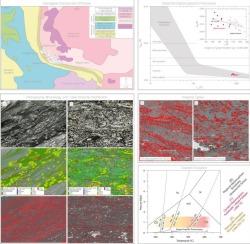澳大利亚松溪造山带Leliyn矿床接触变质片状石墨成因及特征
IF 3.6
2区 地球科学
Q1 GEOLOGY
引用次数: 0
摘要
澳大利亚北部地区Pine Creek造山带Leliyn矿床在古元古代Mundogie砂岩(Woodcutters超群)片岩中含有丰富的片状石墨。石墨在花岗岩类岩体(Cullen Supersuite)附近的接触变质作用(≥600℃)中结晶,随后碳质沉积单元的早期区域绿片岩相变质作用形成片岩。随后在低至~ 300-350℃的温度下,逆行热液蚀变产生了绿叶组合(白云母和高岭石组矿物)。石墨主要以≤100µm(通常为20µm)的薄片形式存在于长石-白云母-黑云母基体、片理面和细尺度变形带中。局部较粗的薄片(> 100 μ m)形成于较少片岩,碱长石丰富的岩石中,将资源置于细至中等薄片类别。x射线衍射(XRD)表明结晶度高(d002 ~ 3.357 Å; Lc ~ 800-1300 Å),其系统变化反映了邻近侵入体的热梯度。拉曼光谱和电子显微镜成像显示明显的片内缺陷密度和晶粒尺寸的异质性。这些数据支持沉积物形成的多阶段模型:1)碳质沉积物沉积(最大年龄~ 2284 Ma);2)区域绿片岩相变质作用(~ 1855 Ma; Litchfield事件),片岩内碳富集;3)接触变质作用(~ 1835-1820 Ma; Cullen Supersuite),生产有序的石墨,在较少的片岩域中局部具有较粗的薄片;4)随后的逆行热液蚀变,增强了薄片内部微观结构的非均质性和晶体嵌合。晶粒尺度拉曼测温记录的表观温度为~ 390-620°C,反映了接触变质作用和热液套印作用,而体谱显示的沉积尺度估计为~ 500-530°C。综上所述,Leliyn鳞片石墨结晶度高,具有很强的资源开发潜力。该研究强调了多尺度表征的预测价值,并强调了松溪造山带和世界上类似的地形是片状石墨勘探的有希望的目标。本文章由计算机程序翻译,如有差异,请以英文原文为准。

Genesis and characteristics of contact-metamorphic flake graphite from the Leliyn deposit, Pine Creek Orogen (Australia)
The Leliyn deposit in the Pine Creek Orogen (Northern Territory, Australia) hosts abundant flake graphite within Paleoproterozoic schists of the Mundogie Sandstone (Woodcutters Supergroup). Graphite crystallized during contact metamorphism (≥600 °C) adjacent to granitoid intrusions (Cullen Supersuite), following earlier regional greenschist-facies metamorphism of carbonaceous sedimentary units, which imparted schistosity. Subsequent retrograde hydrothermal alteration at temperatures as low as ∼ 300–350 °C produced phyllic assemblages (muscovite and kaolinite-group minerals). Graphite occurs mainly as flakes ≤ 100 µm (often < 20 µm) within feldspar-muscovite-biotite matrices, foliation planes, and fine-scale deformation zones. Locally, coarser flakes (> 100 µm) formed in less schistose, alkali-feldspar-rich rocks, placing the resource in the fine- to medium-flake category. X-ray diffraction (XRD) indicates high crystallinity (d002 ∼ 3.357 Å; Lc ∼ 800–1300 Å), with systematic variations reflecting thermal gradients from adjacent intrusions. Raman spectroscopy and electron-microscopy imaging reveal pronounced intra-flake heterogeneity in defect density and crystallite size. These data support a multi-stage model for deposit formation: 1) deposition of carbonaceous sediments (maximum age ∼ 2284 Ma); 2) regional greenschist-facies metamorphism (∼ 1855 Ma; Litchfield Event), concentrating carbon within schistosity; 3) contact metamorphism (∼ 1835–1820 Ma; Cullen Supersuite), producing well-ordered graphite, with locally coarser flakes in less schistose domains; and 4) subsequent retrograde hydrothermal alteration, which enhanced microstructural heterogeneity and crystallite mosaicking within flakes. Grain-scale Raman thermometry records apparent temperatures of ∼ 390–620 °C, reflecting contact metamorphism and hydrothermal overprinting, while bulk spectra yield narrower deposit-scale estimates of ∼ 500–530 °C. Overall, the Leliyn flake graphite is highly crystalline and shows strong potential for resource development. This study highlights the predictive value of multi-scale characterization and underscores the Pine Creek Orogen—and similar terrains worldwide—as promising targets for flake graphite exploration.
求助全文
通过发布文献求助,成功后即可免费获取论文全文。
去求助
来源期刊

Ore Geology Reviews
地学-地质学
CiteScore
6.50
自引率
27.30%
发文量
546
审稿时长
22.9 weeks
期刊介绍:
Ore Geology Reviews aims to familiarize all earth scientists with recent advances in a number of interconnected disciplines related to the study of, and search for, ore deposits. The reviews range from brief to longer contributions, but the journal preferentially publishes manuscripts that fill the niche between the commonly shorter journal articles and the comprehensive book coverages, and thus has a special appeal to many authors and readers.
 求助内容:
求助内容: 应助结果提醒方式:
应助结果提醒方式:


